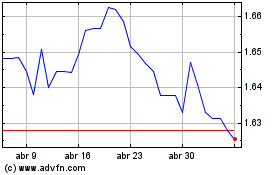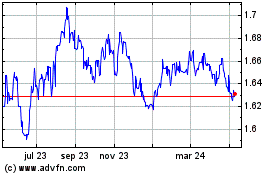Euro Falls Amid Risk Aversion On Trade Worries
11 Septiembre 2018 - 5:02AM
RTTF2
The euro slipped against its major counterparts in the European
session on Tuesday amid risk aversion, as investors awaited fresh
developments in U.S.-China trade tensions for direction.
Fears over a trade war escalated following news that China has
asked the World Trade Organization to authorize the imposition of
trade sanctions on the U.S.
Survey data from the Centre for European Economic Research
showed that German economic sentiment improved more-than-expected
in September.
The economic sentiment indicator climbed to -10.6 from -13.7 in
August. Economist had expected a modest improvement in the index to
-13.5.
Data from Eurostat showed that Eurozone employment increased at
a steady pace in the second quarter.
Employment increased 0.4 percent sequentially in the second
quarter, the same rate as seen in the first quarter. The annual
growth also remained unchanged, at 1.5 percent.
The euro rose against its major opponents in the Asian session,
with the exception of the pound.
The euro retreated to 1.1565 against the greenback, from a 4-day
high of 1.1644 hit at 3:15 am ET. If the euro falls further, 1.13
is likely seen as its next support level.
Having advanced to a 5-day high of 129.83 against the yen at
3:15 am ET, the single currency reversed direction and eased to
128.77. The euro is poised to find support around the 126.00
level.
Data from the Ministry of Economy, Trade and Industry showed
that Japan's tertiary industry activity recovered in July.
The tertiary industry activity index edged up 0.1 percent on
month in July, in line with expectations, after declining by
revised 0.6 percent in June.
The single currency dropped to 1.1264 against the franc, after
rising to near a 2-week high of 1.1344 at 2:45 am ET. On the
downside, 1.08 is possibly seen as the next support level for the
euro.
The euro hit near a 6-week low of 0.8876 against the pound,
reversing from a high of 0.8938 touched at 4:45 am ET. The euro is
seen finding support around the 0.87 mark.
Data from the Office for National Statistics showed that the UK
unemployment rate remained unchanged at the lowest since 1975.
The unemployment rate came in at 4 percent in three months to
July, according to labor force survey. This was the lowest rate
since February 1975.
The euro pared gains to 1.5223 against the loonie, from a 4-day
high of 1.5294 hit at 3:15 am ET. Next key support for the euro is
seen around the 1.51 region.
On the flip side, the euro extended gains to 1.7813 against the
kiwi, marking a 3-year high. Further uptrend may take the euro to a
resistance around the 1.80 level.
Data from Statistics New Zealand showed that New Zealand credit
card spending climbed a seasonally adjusted 1.1 percent on month in
August, following the 0.5 percent gain in July.
Retail credit card spending climbed 1.0 percent on month,
accelerating from 0.7 percent in the previous month.
The euro held steady against the aussie, after having advanced
to a 3-year high of 1.6347 at 3:45 am ET. At yesterday's close, the
pair was worth 1.6293.
Data from the National Australia Bank showed that Australia's
business confidence weakened in August, while business conditions
improved from last month.
The business confidence index fell to +4, the lowest since
August 2016, from +7 in July. Meanwhile, the business conditions
index rose around 2 points to 15 in August.
Looking ahead, U.S. wholesale inventories for July will be out
in the New York session.
Euro vs AUD (FX:EURAUD)
Gráfica de Divisa
De Mar 2024 a Abr 2024

Euro vs AUD (FX:EURAUD)
Gráfica de Divisa
De Abr 2023 a Abr 2024
